| |
LEGEND:
 |
 |
|
Link to a PDF document |
 |
 |
|
Link to non-governmental site and does not
necessarily represent the views of the CDC |

|
 |
| Adobe
Acrobat (TM) Reader needs to be installed on
your computer in order to read documents in PDF format.
Download the Reader.
|
|
 |
 |
 |

| 
|
AIDS by Region, 2006 |
 |
 |
|
Instructions for downloading and using
HIV/AIDS surveillance slides.
Download the
complete slide set:
While the content is in the public domain and
no copyright restriction applies,
we do ask that users preserve the slides in
their current format and cite CDC as the
source.
|

Slide 1
Estimated Numbers of AIDS Cases and Rates (per 100,000 population) among Adults and Adolescents, by Region 2006—50 States and DC
PDF
File
 or
PPT
File or
PPT
File |
|
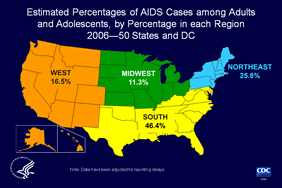
Slide 2
Estimated Percentages of AIDS Cases among Adults and Adolescents, by Percentage in each Region 2006—50 States and DC
PDF
File
 or
PPT
File
or
PPT
File |
|

Slide 3
Estimated Numbers of AIDS Cases among Adults and Adolescents, by Region 1996–2006—50 States and DC
PDF
File
 or
PPT
File or
PPT
File |
|

Slide 4
Estimated Numbers of Adults and Adolescents Living with AIDS, by Region 1996–2006—50 States and DC
PDF
File
 or
PPT
File or
PPT
File |
|

Slide 5
Estimated AIDS Rates among Adults and Adolescents by Region and Size of Place of Residence 2006—50 States and DC
PDF
File
 or
PPT
File or
PPT
File |
|

Slide 6
Northeast Region—Estimated Numbers of AIDS Cases and Rates (per 100,000 population) among Adults and Adolescents by State, 2006 N = 9,483
PDF
File
 or
PPT
File or
PPT
File |
|
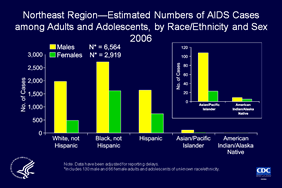
Slide 7
Northeast Region—Estimated Numbers of AIDS Cases among Adults and Adolescents, by Race/Ethnicity and Sex 2006
PDF
File
 or
PPT
File or
PPT
File |
|
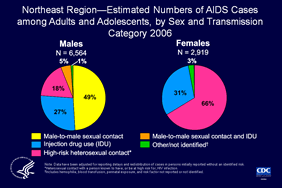
Slide 8
Northeast Region—Estimated Numbers of AIDS Cases among Adults and Adolescents, by Sex and Transmission Category 2006
PDF
File
 or
PPT
File
or
PPT
File |
|

Slide 9
Northeast Region—Estimated Numbers of AIDS Cases among Adults and Adolescents, by Sex, Race/Ethnicity and Population of Area of Residence, 2006
N = 54,230
PDF
File
 or
PPT
File or
PPT
File |
|

Slide 10
Midwest Region—Estimated Numbers of AIDS Cases and Rates (per 100,000 population) among Adults and Adolescents, by State, 2006 N = 4,160
PDF
File
 or
PPT
File or
PPT
File |
|

Slide 11
Midwest Region—Estimated Numbers of AIDS Cases among Adults and Adolescents, by Race/Ethnicity and Sex 2006
PDF
File
 or
PPT
File or
PPT
File |
|
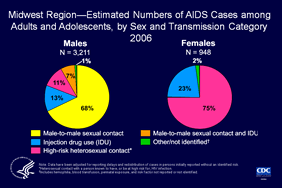
Slide 12
Midwest Region—Estimated Numbers of AIDS Cases among Adults and Adolescents, by Sex and Transmission Category 2006
PDF
File
 or
PPT
File or
PPT
File |
|
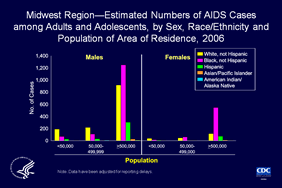
Slide 13
Midwest Region—Estimated Numbers of AIDS Cases among Adults and Adolescents, by Sex, Race/Ethnicity and Population of Area of Residence, 2006
PDF
File
 or
PPT
File or
PPT
File |
|

Slide 14
Estimated Number of New HIV Infections among Adult and Adolescent Men Who Have Sex with Men, by Race/Ethnicity and Age Group—United States, 2006 N = 28,700
PDF
File
 or
PPT
File or
PPT
File |
|
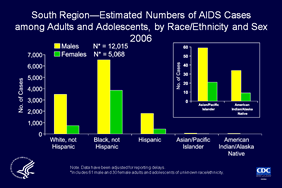
Slide 15
South Region—Estimated Numbers of AIDS Cases among Adults and Adolescents, by Race/Ethnicity and Sex 2006
PDF
File
 or
PPT
File or
PPT
File |
|
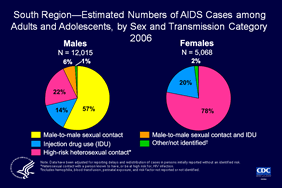
Slide 16
South Region—Estimated Numbers of AIDS Cases among Adults and Adolescents, by Sex and Transmission Category 2006
PDF File
 or
PPT File
or
PPT File |
|
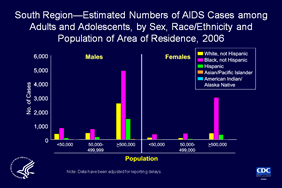
Slide 17
South Region—Estimated Numbers of AIDS Cases among Adults and Adolescents, by Sex, Race/Ethnicity and Population of Area of Residence, 2006
PDF File
 or
PPT File
or
PPT File |
|
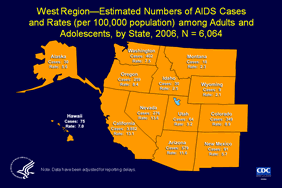
Slide 18
West Region—Estimated Numbers of AIDS Cases and Rates (per 100,000 population) among Adults and Adolescents, by State, 2006, N = 6,064
PDF File
 or
PPT File
or
PPT File |
|
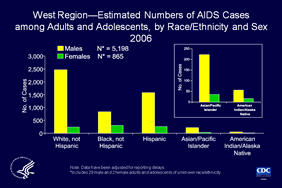
Slide 19
West Region—Estimated Numbers of AIDS Cases among Adults and Adolescents, by Race/Ethnicity and Sex 2006
PDF File
 or
PPT File
or
PPT File |
|
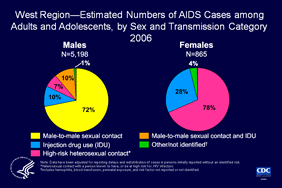
Slide 20
West Region—Estimated Numbers of AIDS Cases among Adults and Adolescents, by Sex and Transmission Category 2006
PDF File
 or
PPT File
or
PPT File |
|
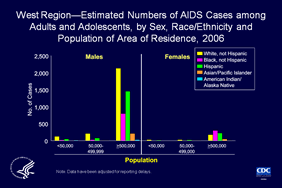
Slide 21
West Region—Estimated Numbers of AIDS Cases among Adults and Adolescents, by Sex, Race/Ethnicity and Population of Area of Residence, 2006
PDF File
 or
PPT File
or
PPT File |
|
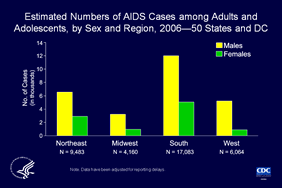
Slide 23
Estimated Numbers of AIDS Cases among Adults and Adolescents, by Sex and Region, 2006—50 States and DC
PDF File
 or
PPT File
or
PPT File |
|
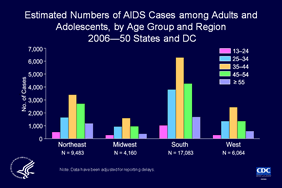
Slide 24
Estimated Numbers of AIDS Cases among Adults and Adolescents, by Age Group and Region 2006—50 States and DC
PDF File
 or
PPT File
or
PPT File |
|
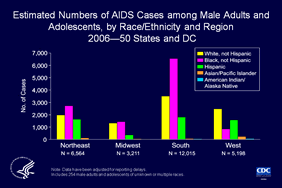
Slide 25
Estimated Numbers of AIDS Cases among Male Adults and Adolescents, by Race/Ethnicity and Region 2006—50 States and DC
PDF File
 or
PPT File
or
PPT File |
|
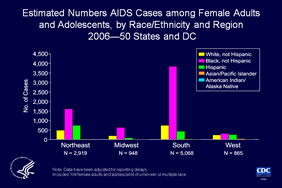
Slide 26
Estimated Numbers AIDS Cases among Female Adults and Adolescents, by Race/Ethnicity and Region 2006—50 States and DC
PDF File
 or
PPT File
or
PPT File |
|
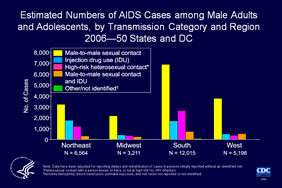
Slide 27
Estimated Numbers of AIDS Cases among Male Adults and Adolescents, by Transmission Category and Region 2006—50 States and DC
PDF File
 or
PPT File
or
PPT File |
|
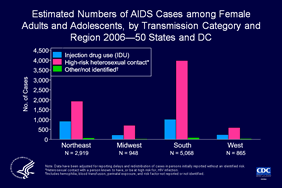
Slide 28
Estimated Numbers of AIDS Cases among Female Adults and Adolescents, by Transmission Category and Region 2006—50 States and DC
PDF File
 or
PPT File
or
PPT File |
|

Slide 29
Northeast Region—Estimated Numbers of AIDS Cases among Male Adults and Adolescents, by Race/Ethnicity and Population of Area of Residence, 2006
PDF File
 or
PPT File
or
PPT File |
|
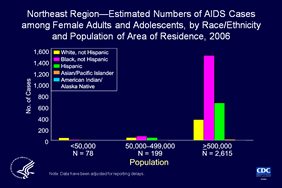
Slide 30
Northeast Region—Estimated Numbers of AIDS Cases among Female Adults and Adolescents, by Race/Ethnicity and Population of Area of Residence, 2006
PDF File
 or
PPT File
or
PPT File |
|
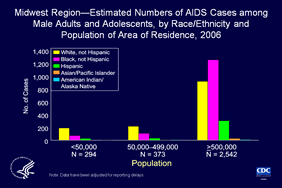
Slide 31
Midwest Region—Estimated Numbers of AIDS Cases among Male Adults and Adolescents, by Race/Ethnicity and Population of Area of Residence, 2006
PDF File
 or
PPT File
or
PPT File |
|
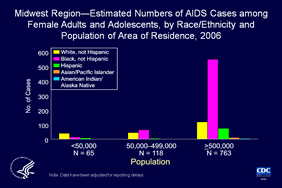
Slide 32
Midwest Region—Estimated Numbers of AIDS Cases among Female Adults and Adolescents, by Race/Ethnicity and Population of Area of Residence, 2006
PDF File
 or
PPT File
or
PPT File |
|
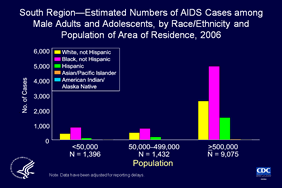
Slide 33
South Region—Estimated Numbers of AIDS Cases among Male Adults and Adolescents, by Race/Ethnicity and Population of Area of Residence, 2006
PDF File
 or
PPT File
or
PPT File |
|
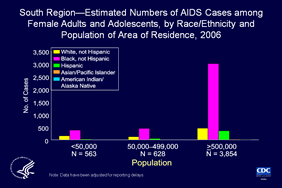
Slide 34
South Region—Estimated Numbers of AIDS Cases among Female Adults and Adolescents, by Race/Ethnicity and Population of Area of Residence, 2006
PDF File
 or
PPT File
or
PPT File |
|
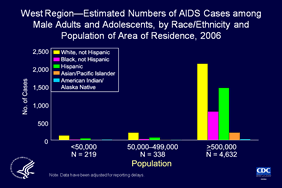
Slide 35
West Region—Estimated Numbers of AIDS Cases among Male Adults and Adolescents, by Race/Ethnicity and Population of Area of Residence, 2006
PDF File
 or
PPT File
or
PPT File |
|
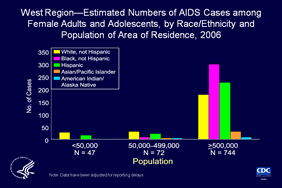
Slide 36
West Region—Estimated Numbers of AIDS Cases among Female Adults and Adolescents, by Race/Ethnicity and Population of Area of Residence, 2006
PDF File
 or
PPT File
or
PPT File |
|
|
|
|